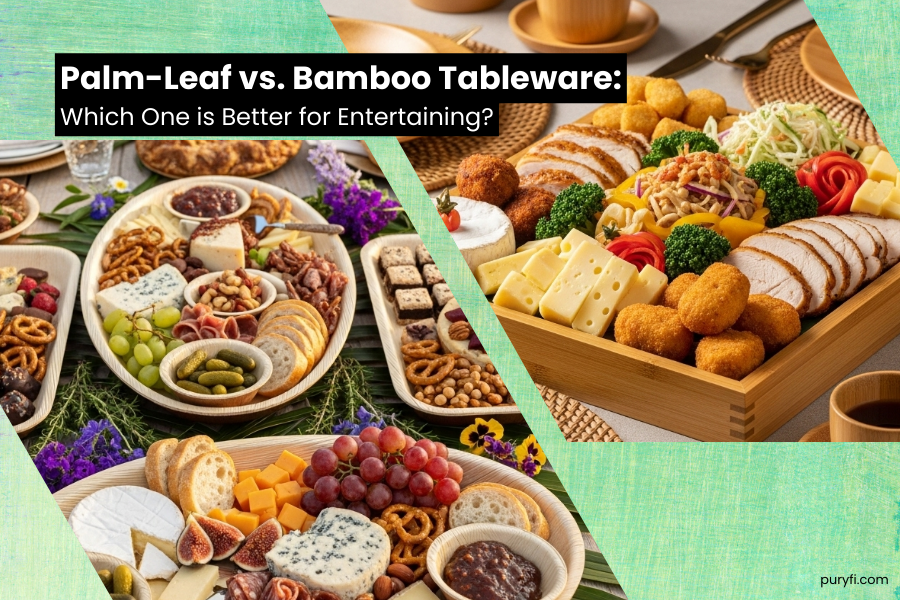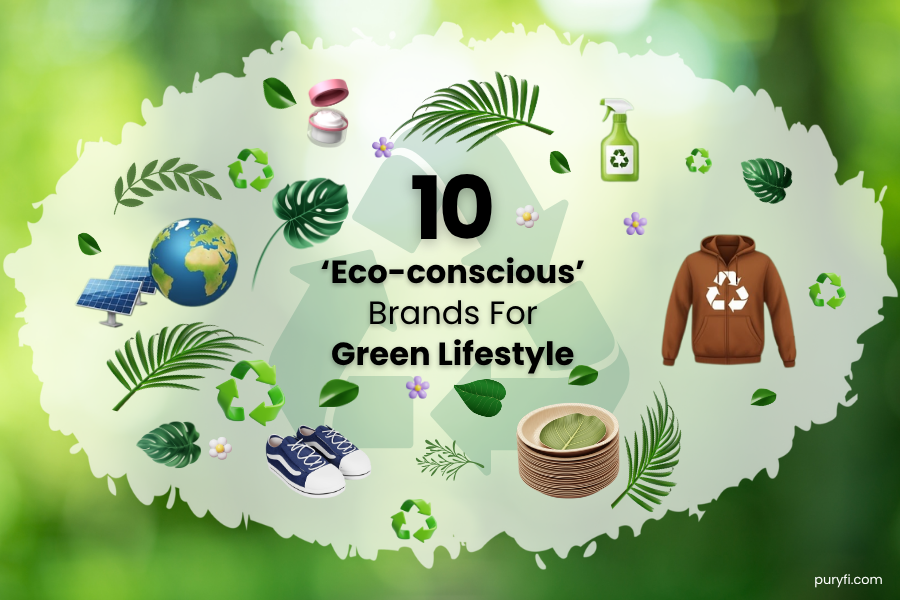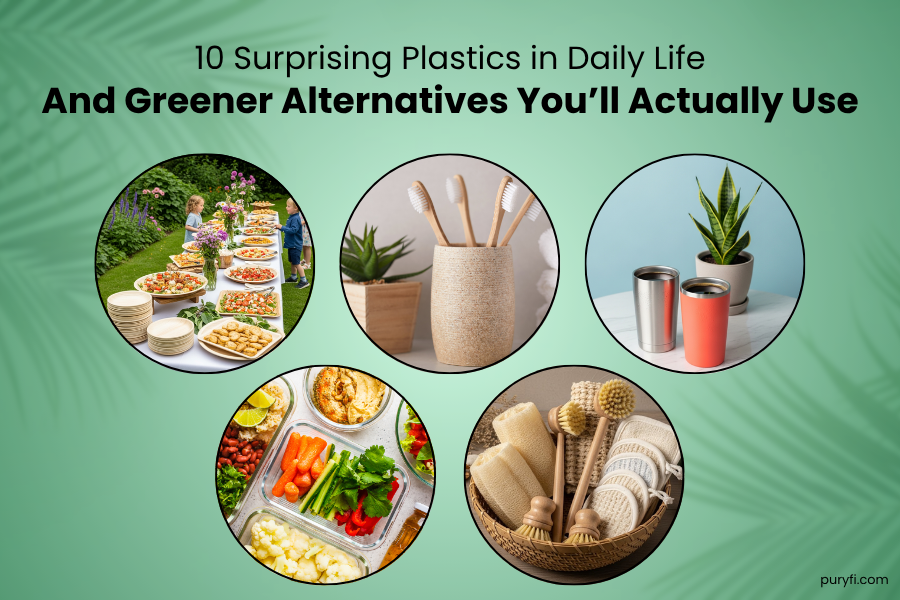In today’s age of eco-conscious entertaining, hosts and event planners are rethinking not just what’s on the menu, but how it’s served. The rise of sustainable living has brought beautiful alternatives to plastic into the spotlight, and among the most visually striking and planet-friendly of these are palm-leaf boards and bamboo charcuterie boards.
While both options fall under the umbrella of eco-friendly serving boards, they differ in terms of materials, use cases, environmental impact, and long-term value. So, which one should you choose when planning your next gathering?
Let’s explore this in depth.
Palm leaf vs Bamboo boards Comparison
Understanding the Materials
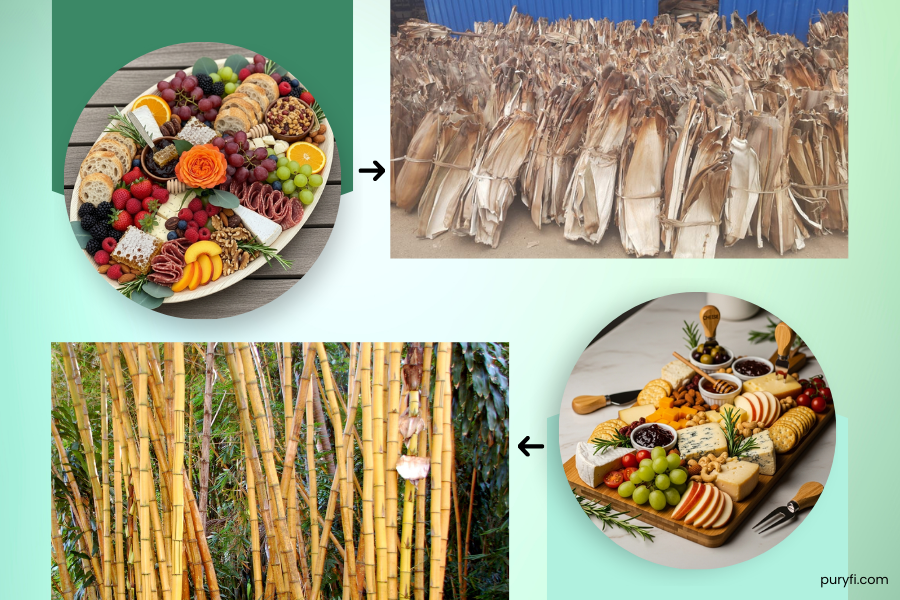
Palm-leaf boards are crafted from naturally fallen Areca palm leaves. These leaves are collected, cleaned with water, and heat-pressed into shape without any chemical processing. The result is a sturdy, biodegradable, and completely non-toxic tableware option that brings an organic aesthetic to the table.
Know the detailed manufacturing process of palm leaf tableware in the blog.
Bamboo Boards, on the other hand, are made from the fast-growing bamboo plant. These boards are often treated, shaped, and bonded using adhesives and finishes. While bamboo is a renewable resource, some commercial boards may involve resins or glues that are not biodegradable. The difference in processing is significant: palm-leaf boards are truly compostable dinnerware, whereas bamboo boards, though reusable, may not break down cleanly at the end of their life cycle.
Sustainability Showdown
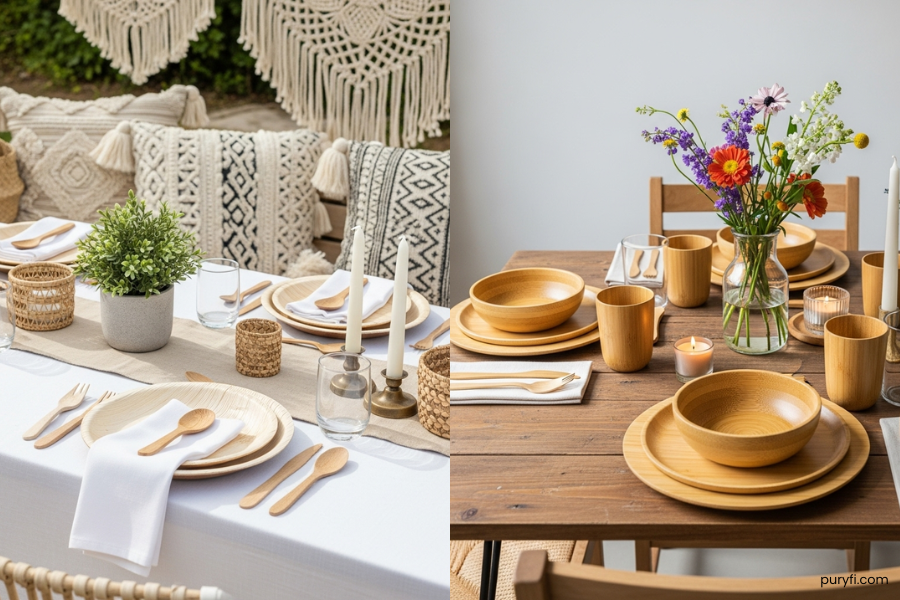
When it comes to living an eco-friendly lifestyle, the materials we use for serving and entertaining matter deeply.
Palm-leaf boards are the epitome of planet-friendly design. They use no additional resources beyond collecting what nature has already discarded. They leave no trace, literally. After use, they can be composted at home and decompose within 60 days. That’s a win for the green planet.
Read how palm leaf tableware is an ideal sustainable tableware.
Bamboo, while a better alternative to plastic, has a more complex sustainability profile. Bamboo is renewable and fast-growing, which makes it an attractive material. However, large-scale bamboo cultivation can involve significant land and water use. Additionally, bamboo boards may require chemical treatments to prevent splitting and mold, reducing their appeal as non-toxic tableware.
From a sustainable dinnerware perspective, palm-leaf wins for disposability and biodegradability, while bamboo boards win for reusability, if well maintained.
Aesthetics and Event Functionality
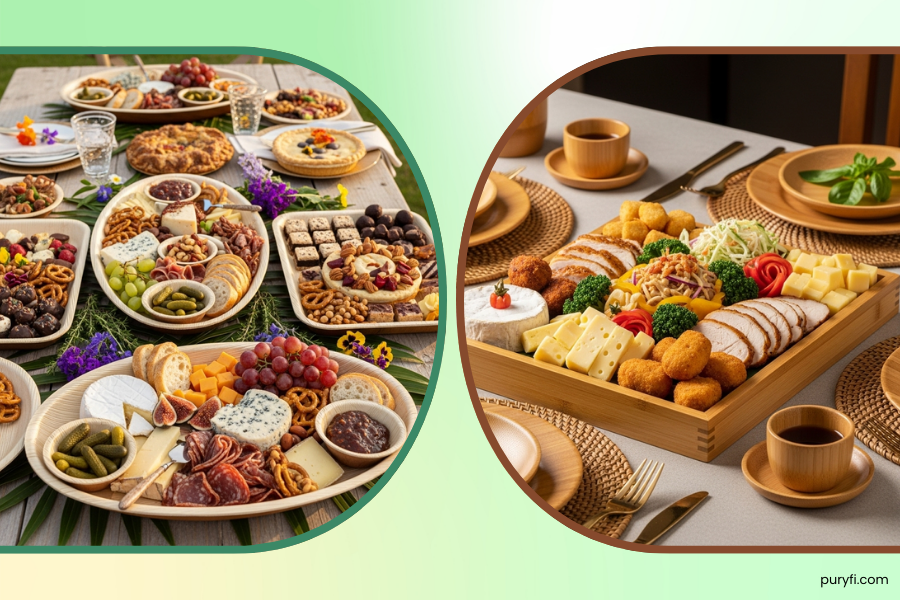
Visual presentation is a key part of entertaining, especially when it comes to charcuterie or dessert spreads. Both palm-leaf and bamboo boards offer aesthetic value, but in distinct ways.
Palm-leaf boards have a natural grain and unique variations in color and texture. Each board is a piece of art. They complement outdoor, rustic, tropical, or eco-chic event themes. Their lightweight makes them ideal for large-scale use, and they add an earthy, authentic look to any table setting.
Know more about the style and functionality of palm leaf tableware here.
Bamboo boards are sleeker and more uniform. Their polished finish suits minimalist or modern design sensibilities. They work beautifully for intimate settings, small gatherings, or as a long-term kitchen staple.
When planning eco-friendly party tableware, think about your event scale and theme. Palm-leaf boards for parties bring convenience and visual charm with zero clean-up. Bamboo boards may suit repeat hosting and gifting scenarios.
Practicality: Clean-Up, Storage, and Safety
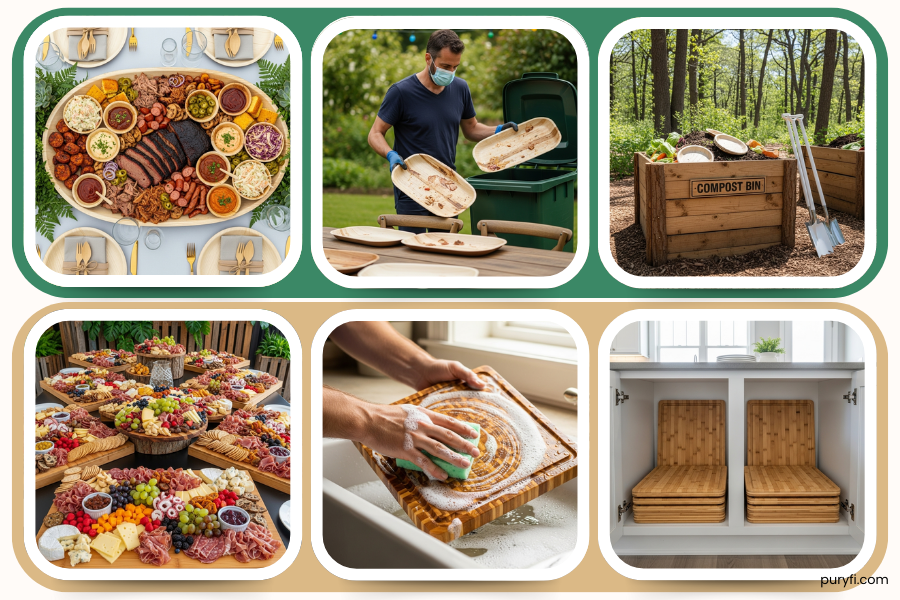
Let’s be honest: after the party, no one wants to deal with hours of washing and storing heavy platters.
Palm-leaf boards require zero maintenance. Use them, compost them, and you’re done. This makes them ideal for events with lots of guests where time and hygiene matter.
In contrast, bamboo boards require careful cleaning and drying to avoid warping or bacterial growth. They also need oiling to maintain their surface. For some, that’s part of their charm. For others, it’s a dealbreaker.
When food safety is a concern, especially with shared platters or outdoor serving, palm-leaf boards shine. They don’t retain oils or food odors, and their one-time-use nature eliminates cross-contamination risks.
End-of-Life: What Happens After Use?
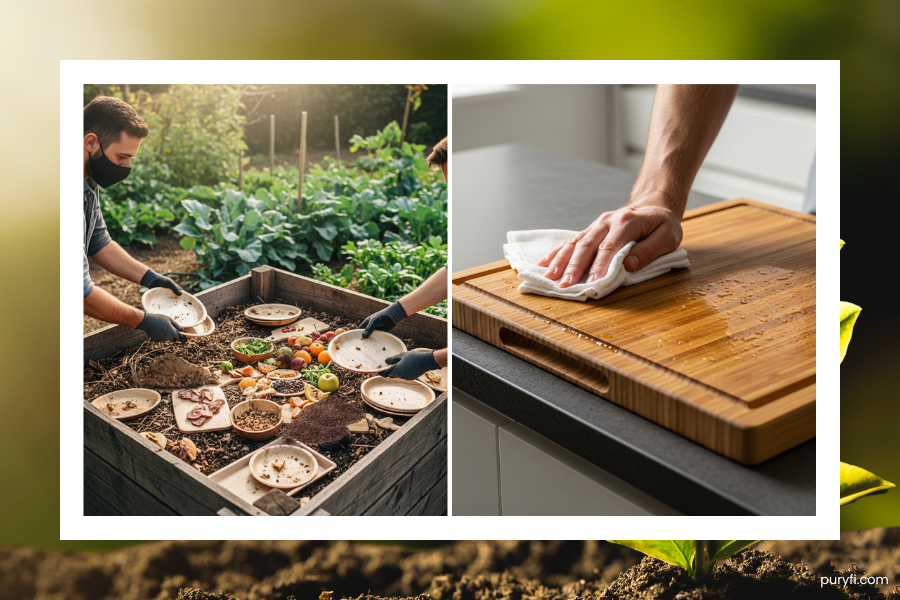
This is where the palm leaf vs bamboo divergence is clear.
Palm-leaf tableware is 100% biodegradable. After use, you can break it up and toss it in your compost pile. Within 60 days, it returns to the earth, enriching the soil without leaving toxins.
Learn more about how to compost palm leaf tableware at home.
Bamboo boards may last for years if cared for properly. But at the end of their life, unless specifically designed to be compostable or recyclable, they often end up in landfills.
If your goal is zero waste, palm-leaf products align beautifully with a sustainable living philosophy.
Cost and Convenience
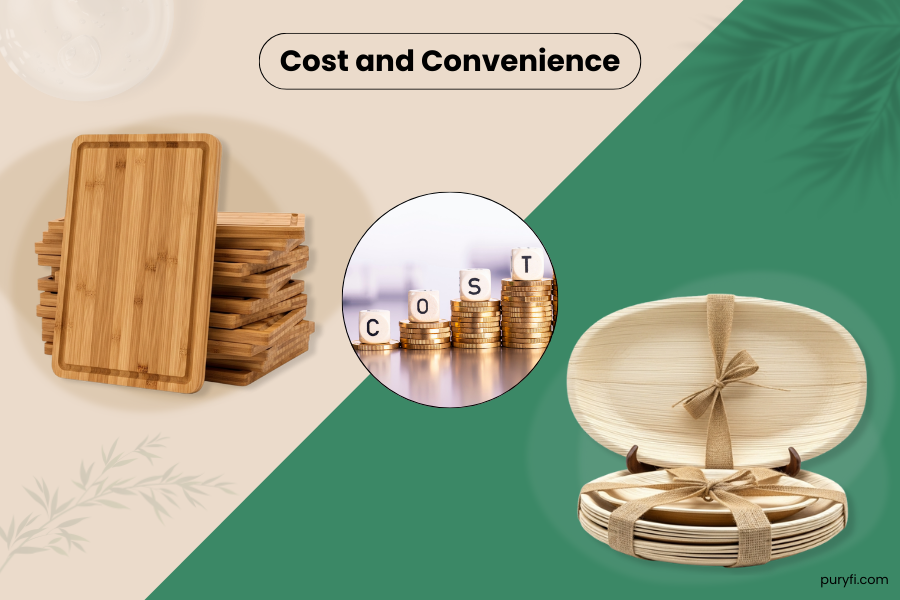
Hosting an event comes with time and budget constraints. Here’s how the two compare:
- Palm-Leaf Boards: Affordable for bulk purchases, especially for large events. No need for washing, storing, or worrying about damage.
- Bamboo Boards: Higher upfront cost. Long-term savings if reused frequently. Requires space and upkeep.
For weddings, showers, or eco-conscious gatherings, palm-leaf boards offer unmatched eco-friendly disposable plates functionality without sacrificing style.
Final Verdict: What Should You Choose?
Choosing between palm leaf vs bamboo charcuterie boards comes down to your priorities:
- Want zero waste and zero cleanup? – Choose palm-leaf boards.
- Hosting a large event or outdoor party? – Palm-leaf again.
- Prefer long-term reuse at home? – Bamboo may be for you.
- Seeking something beautiful and compostable? – Palm-leaf delivers.
Both options represent a step away from plastic, which is a win. But for those striving toward eco-conscious choices, minimal footprint, and alignment with a green planet vision, palm leaf tableware is a smart, beautiful, and functional choice.
Whether you’re planning a quiet dinner or a big celebration, the materials you serve on say a lot about your values. Choosing compostable, eco-conscious tableware, like palm-leaf boards, helps you entertain with care for the planet.”
Ready to upgrade your event with compostable, planet-friendly charm? Explore Puryfi’s premium collection of eco-friendly tableware and serve with purpose.
Let your next gathering leave behind memories, not waste.


